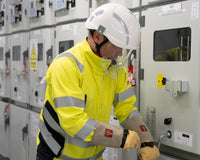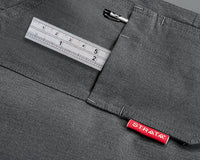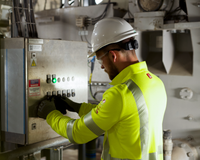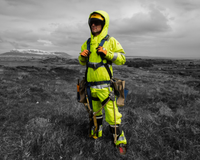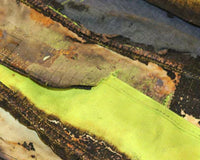ASTM F1506 outlines the performance specifications for flame-resistant clothing worn by workers who are at risk of arc flash exposure in the United States. Electric workers are at risk of electric arc flash and other thermal hazards. It is, therefore, crucial they have adequate protection by wearing the appropriate flame-resistant and arc-rated clothing.
The ASTM F1506 standard
ASTM F1506 is an American Society for Testing and Materials (ASTM) safety standard that sets the performance specification for flame-resistant textile materials for wearing apparel for use by electrical workers exposed to momentary electric arc and related thermal hazards.
The ASTM F1506 performance specification covers the required design characteristics and test methods for the flame resistance of textile materials of protective clothing worn by electrical workers. These specifications ensure the garments can withstand and minimise the risks of momentary electric arc exposure and related thermal hazards, such as exposure to open flame and radiant heat.
This standard outlines performance requirements such as fabric flame resistance, heat resistance, and tear strength. These performance requirements use established test methods to assess the Arc Thermal Performance Value (ATPV) and Breakopen Threshold Energy (EBT) of the textile material. These test methods are used to determine the level of protection offered by the flame-resistant clothing.
Compliance with ASTM F1506 ensures that protective clothing meets the necessary safety standards for arc flash protection.
ASTM F1506-22
The latest version of the ASTM F1506 safety standard is ASTM F1506-22. This revision supersedes the previous version of ASTM F1506-20a.
Some notable changes made during the ASTM F1506-22 update include:
- Requirement in subsection 6.4.7 was revised so that only one arc rating should be in the label with description of how to choose that arc rating
- Subsections 5.2 and 5.3 for lot testing requirements on fabric were revised, clearly defining which tests are required on fabrics for lot testing and frequency for each
- Appendix X2 was added. This new appendix lists every change made to the ASTM F1506 standard since its 1998 revision
Flame resistant (FR) and arc rated (AR) clothing
Flame resistant (FR) clothing is specifically designed to protect the wearer against flames and thermal injury caused by exposure to flames, sparks, or heat sources. FR clothing is engineered to self-extinguish once the source of ignition, such as a flame or an electric arc, is removed.
An electric arc flash occurs when there is a sudden and intense release of electrical energy. The event of an electric arc or arc flash occurring can be hazardous for anyone in the nearby vicinity. Arc rated (AR) clothing, therefore, is specifically designed to protect the wearer against the thermal hazards of an electric arc flash, such as burns.
While all AR clothing is flame resistant, not all FR clothing has an arc rating. ASTM F1506 outlines the performance specifications for flame-resistant and arc-rated clothing. This standard, therefore, helps workers ensure their work clothing offers the level of protection needed.
ASTM F1506 compliance requirements and test methods
To comply with ASTM F1506, protective clothing worn by electric workers should be able to sufficiently protect against momentary electric arc and related thermal hazards.
Before deciding whether FR or AR clothing is required, organisations should conduct thorough risk assessments of the work environment and activities to identify any arc flash hazards. From here, they can determine whether they need to supply FR clothing that meets the ASTM F1506 requirements, and the level of protection required.
ASTM F1506 should be used to evaluate and determine the properties of the materials, products, or assemblies in response to heat and flame under laboratory conditions. It should not be used to describe or appraise the fire hazard or fire risk of materials, products, or assemblies under actual fire conditions.
The textile materials used in ASTM F1506 clothing must meet specific performance requirements for flame resistance, including the ability to resist ignition, melting, dripping, or continued combustion, and to self-extinguish once the ignition source is removed.
The test methods used under ASTM F1506 will evaluate the protective and performance properties of the garments, ensuring they meet the performance requirements of the standard for flame resistance, arc rating, and mechanical durability.
The flame resistance of ASTM F1506 compliant clothing is assessed using the ASTM D6413 ‘vertical flame test’.
The arc rating of ASTM F1506 compliant clothing is assessed using the ASTM F1959 ‘arc rating’ test.
A further five tests are conducted to assess the mechanical durability of ASTM F1506 protective clothing. These tests include:
- American Association of Textile Chemists and Colorists (AATCC) 61 Method 2A, known as the “Colorfastness & Laundering Test” – This test ensures the garment colour remains consistent when laundered
- “The Burst Test”, as per ASTM D3786 – During the burst test, pressured is applied to the material to test its resistance to bursting using a hydraulic or pneumatic diaphragm bursting tester
- “Elmendorf Tear Test”, as per ASTM D1424 – This test examines the tear resistance of the material by measuring the force required to propagate an existing tear in the material
- “The Break Test”, as per ASTM D5034 – This test assesses the breaking and elongation resistance of the fabric by using a mechanical apparatus to pull the fabric from top and bottom
- “Dimensional Change Test”, as per AATCC 135 – This test evaluates the impact home laundry procedures can have on the material dimensions. This is done by subjecting the fabric to several methods of home laundering procedures and measuring the dimensional (length and width) change occurred
Garments that meet ASTM F1506 also comply with OSHA 1910.269, NESC, and NFPA 70E.



